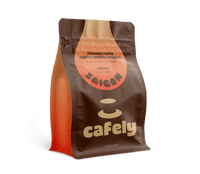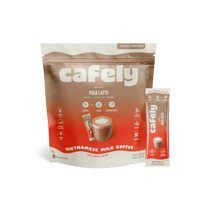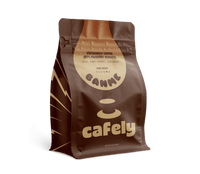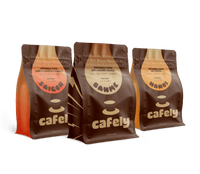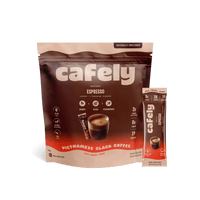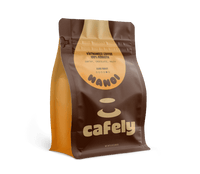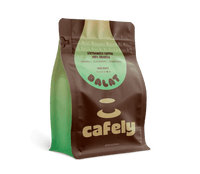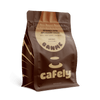It's easier than you might think to make a stylish, rustic coffee table yourself.
Of course, you could buy one, but making a coffee table yourself provides joy and a sense of achievement. It also allows you to customize it to your taste and space.
In this guide, you'll learn how to craft a simple but stylish centerpiece for your living room. You won't need a full woodworking shop, but you will need some basic power tools. If you have a circular saw, sander, and a power drill, you'll be up to the task at hand.
What Do You Need to Make a Coffee Table?

This simple, rustic coffee table only requires one timber size, a few screws, and some dowel to make. The materials should come to under $150 and fit in the back of your car. However, you will need a selection of tools you may not have in your garage.
Here's what you need to make a simple, rustic coffee table:
Tools Needed
- Cordless Drill — You'll need a power drill capable of drilling pilot holes, boring dowel holes up to 22 mm (0.86”), and driving 2”+ screws.
- Drill Bit Selection — You’ll need a selection of wooden drill bits and drivers for drilling pilot holes and driving screws.
- Spade Bit — A large 22 mm (0.86") spade drill bit (hole borer) is needed to make holes for dowel plugs.
- Circular Saw — You'll need a circular saw or miter saw (chop saw) to accurately cut boards. If you don't have either of these and you're confident with your accuracy, you can use a sharp hand saw.
- Electric Sander — An electric sander and a range of pads in different grits are essential to achieve a super-fine finish. You can sand by hand manually, but it'll take some serious elbow grease and a considerable amount of time.
- Carpenter’s Square — This will help you mark cuts at a 90° angle.
- Carpenter’s Pencil — Used for marking cuts on wood.
- Soft Mallet — A soft rubber or wooden mallet is useful for joining boards and knocking in dowels.
- Fine Hand Saw — A small, sharp hand saw will be used to cut dowels level and touch up ill-fitting joins.
- G Clamps — Clamps are useful for holding joins tight while the glue hardens.
Materials Needed
- 2x12” Boards — The same timber will be used to make the entire table. The boards will be doubled up, so we recommend timber with a 12” width or more (this will create a coffee table with a 24”+ width).
- 0.86” Hardwood Dowel — You will use a dowel to disguise the screws on the table. A 22 mm (0.86") dowel provides the best look. Opt for hardwood to avoid shrinkage.
- 2.5” Wood Screws — These will be used to connect the tabletop to the legs. Opt for longer screws if your boards are thicker than 2”.
- 0.39” Wooden Plugs — 10 mm (0.39”) wooden plugs will be used to join the tabletop.
- Joinery-Grade Wood Glue — Wood glue will be used to strengthen the joins.
- Stain or Varnish — Select a stain and/or varnish of your choice to treat and protect your coffee table.
How to Make a Basic Coffee Table: Step-by-Step
This coffee table is surprisingly easy to make. You can build this table in a day, but it's best to set aside a weekend so you can spend plenty of time perfecting its look for your home.
Here's how to make a rustic coffee table, step by step:
1. Measure Your Space
First, measure the space you want your coffee to sit in. Think about the legroom between the sofa and coffee table as well as the height of your sofa.
Take some time during this stage and draw a few rough sketches to get an idea of how you want the table to look in the space. Write down the height, width, and length clearly once you're happy with the dimensions of the space.
Note: It's best to round the measurements to the nearest inch or centimeter — this will make marking and cutting much easier.
2. Gather Your Materials
Once you've decided on your measurements, it's time to make a materials list and gather everything you need.
First, take the width of your table and half it — this will give you the width of timber you need because we'll be using two boards for the tabletop. For example, a 30” (76 cm) wide tabletop will require two 15” (38 cm) wide pieces of timber.
Next, take the length of your table and double it — this will give you the total length of timber you need for the tabletop. For example, a 50” (127 cm) long table requires 100” (254 cm) of timber in total.
Take the height minus the depth (thickness of the timber) and then multiply the measurement by four — each leg will be made from four pieces of timber. For example, a 20” (50 cm) table using 2” (5 cm) thick timber will require four 18” (45 cm) boards — 72” (182 cm) in total.
Add the lengths together and divide it by the longest available lengths you're able to buy. Using our example, we'd need 172” (436 cm) of 15”x2” timber in total. If we can only get boards at 60” (1.5 m) lengths, we'd need just under three boards.
Once you have your timber list, gather everything you need including the fixings, glue, and stain mentioned in the list above.
Note: The measurements you take to work out your timber requirements will act as your cut list…
3. Measure and Mark Your Cuts
Now it's time to get cutting.
Start by squaring up the edges of all your boards by marking them with your carpenter’s square and pencil before cutting them with a miter saw or circular saw.
Measure the lengths needed for your tabletop and legs. Mark the cut lines for your saw using the square.
“Measure twice and cut once” — you only have one shot to cut the right lengths, otherwise, you'll be heading back to the store for more timber.
4. Cut the Boards
Once you're happy with your marks, cut out the two tabletop boards and four leg boards.
Make sure to follow the marks perfectly, accounting for the width of the saw blade.
5. Assemble the Legs
Take the four leg pieces and give the cut edges a rough sand to remove any splintered wood.
Place the legs in pairs and make sure they match up perfectly.
Add a generous amount of wood glue in a cross (X) shape to the face of one leg and gently place the other on top. Make sure the two pieces align, and clamp them together. Repeat with the other pair.
Leave these legs to dry for at least 10 hours.
6. Assemble the Tabletop
Next, we'll attach the two ends of the long boards to create the tabletop. We will use small wooden plugs and wood glue to do this.
First, mark a line on one edge of both boards directly down the center of its depth. If your boards are 2” thick, you'll mark the line down its length at 1”.
Now mark crosses at 10” (25 cm) intervals along the centerline on both pieces. Make sure the marks on both boards match up perfectly — this is where the plugs that connect the two will go.
Once you're 100% happy with your marks, use a 10 mm drill bit and bore out holes ready for the plugs.
Once the holes are drilled, give both edges a light sand to get rid of any splintering.
Tap the plugs into the holes of one of the boards and run a bead of wood glue down its length. Line up the other board and join the two by inserting the plugged board into the holes of the other.
Make sure the two are joined tightly and leave the tabletop to dry.
7. Sand Each Element
Once your tabletop and legs have had time to dry, sand both elements thoroughly.
Start with a heavier grit of sandpaper and work your way down until all the elements are completely smooth.
8. Drill the Pilot Holes
You will now need to mark and drill your pilot holes to join the legs to the tabletop with screws.
Lay the tabletop face-down and place the legs in your desired locations. Make sure they are centered and measure their distance from the edges of the tabletop.
Flip the tabletop over and transfer the measurements to the top. Mark two equally spaced holes for each leg.
Stand the tabletop on the legs in the correct position and pre-drill all four holes — these will ensure the wood doesn't split when you drive the screws.
9. Bore the Dowel Holes
Once you've drilled the pilot holes, take your 22 mm spade drill bit and bore it down into the tabletop. Make sure you don't bore into the wood more than ⅓ of its width.
These holes will hide the screw heads when you insert your dowel plugs. Once you’ve bored out all four holes, clean the edges with sandpaper and shake out any sawdust.
10. Attach the Legs to the Tabletop
Add some glue to the top of the legs and position them in the correct places. Slowly drive screws down through the pilot holes in the tabletop into the legs.
Make sure everything is tight before moving on to the next step.
11. Plug the Screw Holes
Take your length of dowel and cut four lengths to 1” or 2” — this will make it easier to deal with.
Add a small drop of wood glue into each hole in the tabletop and gently tap in each piece of dowel with a rubber or wooden mallet.
Wait for the dowels to dry and then cut them flush with the face of the table top using a hand saw.
12. Sand the Tabletop
Now your coffee table is almost complete.
Sand the tabletop once more, focusing on the dowels to make sure they're flush with the top. Spend time sanding the edges and corners off the table as well to round everything off and give it a smooth, finished look.
14. Stain or Varnish the Coffee Table
Once you're happy with your coffee table, it's time to stain it.
Use a stain or varnish of your choice to treat your table. Start with the underside and legs, eventually working up the sides and onto the face of the tabletop. You may need several coats, depending on the stain or varnish you use.
Leave your table to dry and then place it proudly in your living space.
FAQs: Making a Coffee Table at Home

Want to learn more about making coffee tables at home?
Check out the answers to the FAQs below…
1. How Do You Choose The Right Size for a Coffee Table?
You must consider several different factors when choosing the right size coffee table. Think about the proportion to your sofa and other seating in the room, the height of your seating, the room layout, and the distance from the seating before choosing a coffee table.
2. What Types Of Wood Are Commonly Used for Coffee Tables?
Any type of wood can be used to make a coffee table. However, oak, walnut, maple, pine, teak, and mahogany are popular choices. Typically, softwoods such as pine and Ash are cheaper than hardwoods like oak and walnut.
3. Can You Make a Coffee Table Without Power Tools?
You can make a coffee table without power tools, but it will take considerably longer. Achieving the same level of finish is possible but difficult without electric sanders and saws.
4. What Is The Standard Height for a Coffee Table?
The standard height of a coffee table is between 16 and 18 inches (40 to 46 cm). However, coffee tables can be higher or lower to suit the sofa and seating in your lounge.
5. How Do You Sand a Coffee Table Properly?
To get a smooth finish on a coffee table you should use sandpaper in various grits. Start with coarse grit (80–100) moving on to medium grit (120–150) and finally fine grit (220–320). An electric sander speeds up the process. Make sure to work along the grain rather than against it.
6. Can You Make a Coffee Table From Pallets?
Yes. You can make a coffee table from pallets and reclaimed wood. The timber will take a considerable amount of work to make it presentable but a coffee table made from old pallets will have charm.
7. What’s the Best Varnish for Coffee Tables?
The best varnish for a coffee table depends on your desired finish and durability requirements.
Polyurethane varnish is a durable finish that will protect the wood from scratches and stains. However, it can yellow over time. Lacquer is best for a smooth, high-gloss finish but can scratch easily. Shellac produces a glossy finish that accentuates the wood’s natural color but it's not as durable against heat and water.
8. What’s a Coffee Table Book?
A coffee table book is a large, visually appealing book designed for casual reading or browsing. They typically feature several high-quality images and intriguing topics. They may also be good conversation starters.
9. How Do You Protect a Coffee Table From Scratches?
You can protect a coffee table from scratches by applying varnish, adding a glass top, or using a table runner or cloth. You can also use coasters and placemats when serving food and drinks on your coffee table.
10. Why Should You Use Coasters on a Coffee Table?
You should use coasters on your coffee table to prevent scratches, stains, and heat damage. Placing hot cups of coffee on your coffee table without coasters can leave water rings, heat rings, and stains.
